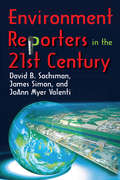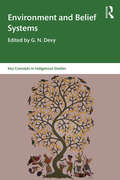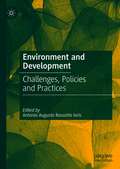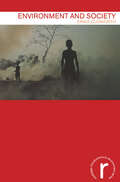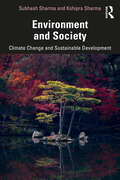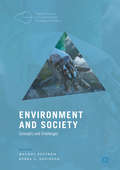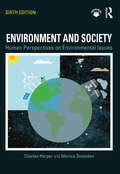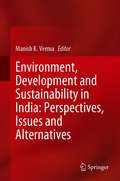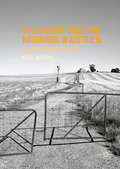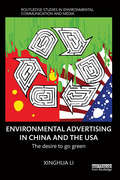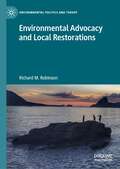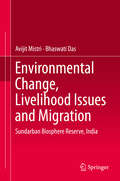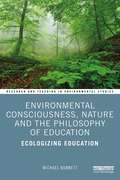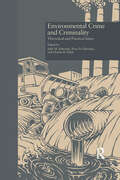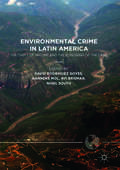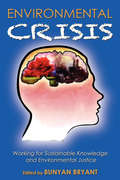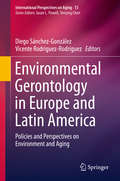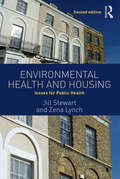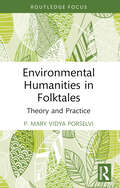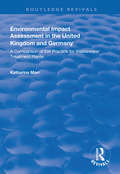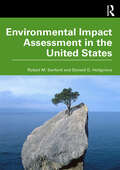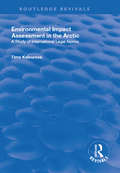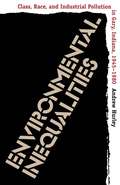- Table View
- List View
Environment Reporters in the 21st Century
by JoAnn Myer ValentiEnvironment Reporters in the 21st Century is the story of a relatively new journalistic beat, environmental reporting. This book explores the development of the environmental beat as a specialty during the last thirty years. It also discusses broader trends within American journalism resulting from technological changes that challenge traditional mediums, especially newspapers and magazines.The book is divided into three parts. The first reviews the literature and explains the methodology. The second describes the results of the authors' research. The third provides in-depth accounts of environment reporters at work. A final chapter puts the research in historical perspective, viewing it in terms of the economic decline of the newspaper business and of local television news.Journalists mediate a constant struggle among thousands of environmental activists, corporate public relations people, government officials, and scientists to shape environmental reporting. This volume tells the story of environmental reporting imaginatively and innovatively.
Environment and Belief Systems (Key Concepts in Indigenous Studies)
by G. N. DevyPart of the series Key Concepts in Indigenous Studies, this book focuses on the concepts that recur in any discussion of nature, culture and society among the indigenous. The book, the first in a five-volume series, deals with the two crucial concepts of environment and belief systems of indigenous peoples from all the continents of the world. With contributions from renowned scholars, activists and experts from around the globe, it presents a salient picture of the environments of indigenous peoples and discusses the essential features of their belief systems. It explores indigenous perspectives related to religion, ritual and cultural practice, art and design, and natural resources, as well as climate change impacts among such communities in Latin and North America, Oceania (Australia, New Zealand and the South Pacific Islands), India, Brazil, Southeast Asia and Africa. Bringing together academic insights and experiences from the ground, this unique book's wide coverage will serve as a comprehensive guide for students, teachers and scholars of indigenous studies. It will be essential reading for those in anthropology, social anthropology, sociology and social exclusion studies, religion and theology, and cultural studies, as well as activists working with indigenous communities.
Environment and Development: Challenges, Policies and Practices
by Antonio Augusto Rossotto IorisThis book provides a comprehensive overview of emerging challenges facing different social groups, policy-makers and the international community related to economic growth, social development and environmental change, social inclusion and regional development. The book undertakes a critical assessment of the tensions associated with the failures of mainstream regulatory approaches and impacts of social and economic policies whilst widening the discussion on the interface between the expansion of the socio-environmental demands, equity and justice. These are crucial challenges, of great importance today and of equal relevance to the Global North and South. The book explores one of the main contradictions of development, the simplification of assessments and narrow consideration of alternatives. Taking this dilemma as its departure point, it goes on to examine the justification, trends and limitations of Western-based development and possible alternatives to fundamentally modify the basis and the rationale of the development process. It considers theoretical and lived experiences of development, paying attention to multiple scales, local realities and economic frontiers. Contributing authors explore policy recommendations and discuss effective practical tools for determining the values different people hold for ecosystem services and territorial resources. They cover the monitoring of change in the provision of ecosystem services that might increase the well-being of vulnerable groups as well as strategies to promote innovation and integrated, equitable and sustainable development.
Environment and Society (Routledge Introductions to Environment: Environment and Society Texts)
by Erika CudworthAt the start of the twenty-first century, it can be argued that human societies have a greater impact on the environment than ever before. We have always been dependent upon, and interacted with, the 'natural' environment. However, the dramatic social changes of the past three centuries, have altered the form of our relationship with non-human nature to the extent that some would see people/planet relations as in a situation of crisis.Environment and Society provides a comprehensive and critical account of the ways in which we can think about the relationship between human societies and the environments with which they interact. It argues that human societies are ecologically embedded, and that environments are often socially embedded and constituted. It makes the different theoretical positions and empirical studies accessible to students, and includes chapter outlines and summaries, annotated further reading, boxed case-studies and discussion points.
Environment and Society: Climate Change and Sustainable Development
by Subhash Sharma Kshipra SharmaThis book presents a comprehensive, lucid, and accessible approach to environmental sociology. It traces the origins of environmental sociology and examines the realist–constructionist debate in ecology for a holistic exploration of the field. The volume: • Presents a step-by-step systematic approach to the study of environmental sociology • Includes case studies from Asia, Africa, Europe, and the Americas and introduces theoretical perspectives from Asia, Africa, and South America to provide a more comprehensive view of the field • Has separate chapters on sustainable development and climate change • Discusses ecological movements in India and highlights environmental issues of the Global South A key text for undergraduates, postgraduates, and civil services aspirants, this book goes beyond western scholarship to include indigenous approaches to the field. It will be indispensable for students of sociology, climate change, environmental studies, and sustainable development.
Environment and Society: Concepts and Challenges (Palgrave Studies in Environmental Sociology and Policy)
by Debra J. Davidson Magnus BoströmThis book offers a critical analysis of core concepts that have influenced contemporary conversations about environment-society relations in academic, political, and civil circles. Considering these conceptualizations are currently shaping responses to environmental crises in fundamental ways, critical reflections on concepts such as the Anthropocene, metabolism, risk, resilience, environmental governance, environmental justice and others, are well-warranted. Contributors to this volume, working across a multitude of areas within environmental social science, scrutinize underlying worldviews and assumptions, asking a common set of key questions: What are the different concepts able to explain? How do they take into account society-environment relations? What social, cultural, or geo-political biases and blinders are inherent? What actions or practices do the concepts inspire? The transdisciplinary engagement and reflexivity regarding concepts of environment-society relations represented in these chapters is needed in all spheres of society—in academia, policy and practice—not the least to confront current tendencies of anti-reflexivity and denialism.
Environment and Society: Human Perspectives on Environmental Issues
by Charles Harper Monica SnowdenThe sixth edition of Environment and Society continues to connect issues about human societies, ecological systems, and environments with data and perspectives from different fields. The text looks at the environment from a primarily sociological viewpoint and is designed for courses in Environmental Sociology and Environmental Issues in departments of Sociology, Environmental Studies, Anthropology, Political Science, and Human Geography. Clearly defined terms and theories help quickly acquaint students from various backgrounds with the material. Every chapter of the sixth edition has been significantly revised with new research, data, concepts, and ideas. Also new to this edition, the end of each chapter features review questions, as well as additional examples and conceptual questions that help make macro-micro links between large-scale issues and the lived experiences.
Environment, Development and Sustainability in India: Perspectives, Issues and Alternatives
by Manish K. VermaThis book provides a comprehensive account of asymmetric linkage in the trilogy of environment, development and sustainability and its impact on society. It examines varied perspectives and issues of development related to environmental destruction and sustainability challenges. By examining the recent trends of development and recording the dilemmas which are creating ecological imbalances, it explores some alternative ways of development to achieve sustainability. Divided into three parts, it has a broad canvass. The first section examines critically the ‘perspectives’ on ecology, practice and ethics, rural development and man–forest interaction in the metropolis. ‘Issues’ of dams, river, agricultural distress, environmental migration, eco-tourism, ecological conservation and land acquisition are assessed in part second. ‘Alternative’ means of development is explored in part third by incorporating chapters on the constructed wetland, biofuels, subsistence economy, water and traditional knowledge practice. This interdisciplinary book is of immense significance to academicians, researchers, postgraduate and graduate-level students of social sciences and environmental studies; policymakers, development practitioners and NGOs working in the area of environment and development.
Environment, Race, and Nationhood in Australia
by Russell McgregorThis new study offers a timely and compelling account of why past generations of Australians have seen the north of the country as an empty land, and how those perceptions of Australia's tropical regions impact current policy and shape the self-image of the nation. It considers the origins of these concerns - from fears of invasion and moral qualms about leaving resources lying idle, from apprehensions about white nationhood coming under international censure and misgivings about the natural attributes of the north - and elucidates Australians' changing appreciations of the natural environments of the north, their shifting attitudes toward race and their unsettled conceptions of Asia.
Environmental Adaptation and Eco-cultural Habitats: A coevolutionary approach to society and nature (Routledge Explorations in Environmental Studies)
by Johannes SchubertIn this challenging and highly original book, the author tackles the dynamic relationships between physical nature and societies over time. It is argued that within each eco-cultural habitat, the relationship between physical nature and society is mediated by specific entanglements between technologies, institutions, and cultural values. These habitat-specific entanglements are neither ecologically nor culturally predetermined, but result from mutual adaptation based on variation (trial and error) and selection. It is shown how a variety of eco-cultural habitats evolves from this coevolutionary process. The book explores how these varieties come into being and how their specific characteristics affect the capacity to cope with environmental or social problems such as flooding or unemployment. There are two case studies illustrating the potential of a coevolutionary understanding of the society-nature nexus. In the first, rural and urban settlement structures are conceptualized as distinct paths of eco-cultural adaptation. It is shown that each of these paths is characterized by predictable spatial correspondences between dwelling technologies, modes of social reproduction, cultural preferences, and related patterns in energy consumption (i.e. social metabolism). The second case study deals with flood protection in liberal and coordinated eco, welfare, and production regimes, drawing on lessons from the Netherlands and Hurricane Katrina in New Orleans. As a contribution to theory in environmental sociology, the coevolutionary perspective developed provides deeper insights into the intricate interplay between physical and social nature.
Environmental Advertising in China and the USA: The desire to go green (Routledge Studies in Environmental Communication and Media)
by Xinghua LiSince the late 1980s, green consumerism has been hailed in the West as an efficient solution to environmental problems. However, Chinese consumers have been slow to warm up to eco-friendly products. Consumers prefer SUVs to hybrid cars, health supplements and snake oil medicines to organic foods and eco-fashion is still secluded in high-end designer studios. These choices contradict the findings of many sustainable lifestyle surveys that claim to register a rising desire for green products among the Chinese. This book examines the psycho-cultural differences that disrupt the translation of "eco-friendly" appeals to China by analyzing environmental advertising. It explores the different notions of "green", the structures of desire that underlies the advertisements, and how they are shaped by ideological, cultural, and historical differences. Rather than arguing the superiority of the American or Chinese version of green consumerism, the book interrogates the role of advertising in the global spread of Western ideologies and explores the possibilities for consumers to resist transnational corporate hegemony in the green movement. This book fills an important gap in the critical scholarship on green marketing and should be of interest to students and scholars of environment studies, green advertising and marketing, environmental communication and media studies, China studies and environmental sociology, ethics and cultural studies.
Environmental Advocacy and Local Restorations (Environmental Politics and Theory)
by Richard M. RobinsonThis book explores the leadership of state and federal environmental agencies and local environmental groups in restoring the degraded rivers that flow into North America’s Great Lakes and other sites in the northeastern industrial corridor of the US. Robinson examines twenty of the forty-eight sites included in the Areas of Concern Program of the Great Lakes Water Quality Agreement between Canada and the US. These twenty include heavily urbanized locales such as those along the River Rouge and Detroit River, but also more pristine locales such as the St. Louis River that flows through Duluth. Additionally, Robinson examines challenging river restorations within the northeastern industrial corridor which are led by effective local environmental advocacy organizations: the Penobscot Nation of Indigenous People, the Mystic River Watershed Association, and the Housatonic River Valley Association. All of these river restorations are led and managed by the environmental experts of (i) state and federal agencies, (ii) academia, and (iii) environmental NGOs. Local restorations of industrially degraded water bodies now compose a significant segment of the environmental movement and, ultimately, Robinson demonstrates that local environmental advocacy organizations can help marshal state and local funding for those efforts.
Environmental Apocalypse in Science and Art: Designing Nightmares (Routledge Studies in Social and Political Thought #79)
by Sergio FavaAt a time when it is clear that climate change adaptation and mitigation are failing, this book examines how our assumptions about (valid and usable) knowledge are preventing effective climate action. Through a cross-disciplinary, empirically-based analysis of climate science and policy, the book situates the failures of climate policy in the cultural history of prediction and its interfaces with policy. Fava calls into question the current interfaces between scientific research and climate policy by tracing multiple connections between modelling, epistemology, politics, food security, religion, art, and the apocalyptic. Demonstrating how the current domination of climate policy by models and scenarios is part of the problem, the book examines how artistic practices are a critical location to ask questions differently, rethink environmental futures, and activate social change. The analysis starts with another moment of climatic change in recent western history: the overlap of the Little Ice Age and the "scientific revolution," during which intense climatic, scientific and political change were contemporary with mathematical calculation of the apocalypse. Dealing with the need for complex answers to complex and urgent questions, this is essential reading for those interested in climate action, interdisciplinary research and methodological innovation. The empirical analyses amount to a methodological experiment, across history of science, theology, art theory and history, architecture, future studies, climatology, computer modelling, and agricultural policy. This book is a major contribution to understanding how we are precluding effective climate action, and designing futures that resemble our worst nightmares.
Environmental Change, Livelihood Issues and Migration: Sundarban Biosphere Reserve, India
by Avijit Mistri Bhaswati DasThis book deals with the out-migration from the UNESCO designated Sundarban Biosphere Reserve in India. It focuses on the question whether out-migration is a consequence of environmental change or livelihood issues and development deficit. It investigates the processes of migration from a broad spectrum, exploring a wide range of economic, social, and demographic factors along with environmental stressors. The processes of migration studied and empirically illustrated include migration stream, migration pattern, reasons for migration, the nexus between migration and social network, aspiration and different human, economic and physical capital. The book adopts a modelistic approach called the Sustainable Livelihood Approach (SLA) to investigate whether migration from Sundarban is an environmental migration or not. In addition it uses the risk perception approach of people’s cognition or ‘affective imagery’ to examine the degree of perceived environmental risk in the means of living, especially farming and fishing, of the islanders of Sundarban. The book will be of interest to researchers and academicians in the areas of migration studies, geography, political science, sociology and economics.
Environmental Consciousness, Nature and the Philosophy of Education: Ecologizing Education (Research and Teaching in Environmental Studies)
by Michael BonnettThis book explores alternative ways of understanding our environmental situation by challenging the Western view of nature as purely a resource for humans. Environmental Consciousness, Nature and the Philosophy of Education asserts that we need to retrieve a thinking that expresses a different relationship with nature: one that celebrates nature's otherness and is attuned to its intrinsic integrity, agency, normativity and worth. Through such receptivity to nature's address we can develop a sense of our own being-in-nature that provides a positive orientation towards the problems we now face. Michael Bonnett argues that this reframing and rethinking of our place in nature has fundamental implications for education as a whole, questioning the idea of human "stewardship" of nature and developing the idea of moral education in a world of alterity and non-rational agents. Drawing on and revising work published by the author over the last 15 years, this book will be essential reading for students and scholars of environmental studies, environmental education, and the philosophy of education.
Environmental Crime and Criminality: Theoretical and Practical Issues (Current Issues in Criminal Justice #Vol. 984)
by Charles B. Fields Sally M. Edwards Terry D. EdwardsFirst published in 1996. Routledge is an imprint of Taylor & Francis, an informa company.
Environmental Crime in Latin America
by Avi Brisman Nigel South Hanneke Mol David Rodríguez GoyesThis book is the first green criminology text to focus specifically on Latin America. Green criminology has always adopted a broad horizon and explicitly emphasised that environmental crimes and harms affect countries and cultures around the world. The chapters collected here illuminate and describe the "theft of nature" and the "poisoning of the land" in Latin America through and from processes of agro-industry expansion, biopiracy, legal and illegal trafficking of free-born non-human animals, and mining. An interdisciplinary study, this collection draws on research from a wide range of international experts on not only green criminology, but also social justice, political ecology and sociology. An engaging and thought-provoking work, this book will be an essential text for anyone interested in current issues in environmental crime.
Environmental Crisis: Working for Sustainable Knowledge and Environmental Justice
by Bunyan BryantOver the years, we have witness unprecedented growth and development that threatens our planet earth as evidenced by environmental degradation, world poverty all of which will be exacerbated by climate change. “Environmental Crisis or Crisis of Epistemology?” explores the ideas that environmental destruction and injustice is integrally related to unsustainable knowledge and the role that knowledge plays in a racially discriminatory and unequal society. It also challenges us to think more critically about certain kinds of growth and development and creating knowledge that is more sustainable, environmentally benign and just and more compatible with the earth’s lifecycle. To continue business as usual without questioning our epistemology could lead to dire and unintended consequences of Herculean proportions. We can and must reverse this perilous trend. We must embarked upon creating knowledge that is more protective of the environment and the inhabitants of the earth.
Environmental Gerontology in Europe and Latin America
by Diego Sánchez-González Vicente Rodríguez-RodríguezThis book looks at the relationships between the physical-social environment and the elderly in Europe and Latin America, from the Environmental Gerontology perspective and through geographical and psychosocial approaches. It addresses the main environmental issues of population ageing, based on an understanding of the complex relationships, adjustments and adaptations between different environments (home, residence, public spaces, landscapes, neighbourhoods, urban and rural environment) and the quality of life of the ageing population, associated with residential strategies and other aspects related to health and dependency. The different levels of socio-spatial analysis are also explored: macro (urban and rural environments, regions and landscapes), meso (neighbourhood, public space) and micro (personal, home and institution). New theoretical and methodological approaches are proposed to analyse the attributes and functions of the physical-social environment of the elderly, as well as new ways of living the ageing process. All will have to respond to the challenges of urbanisation, globalisation and climate change in the 21st century. Also, the different experiences and challenges of public planning and management professionals involved with the growing ageing population are presented, and will require greater association and collaboration with the academic and scientific fields of Environmental Gerontology.
Environmental Health and Housing: Issues for Public Health
by Jill Stewart Zena LynchThe second edition of Environmental Health and Housing has been completely updated to cover the contemporary issues in public health that have emerged in recent years. With a theory and practice approach to public health this edition focuses more on population health; health protection and improvement; and inter-agency approaches to effective intervention in housing and health through evidence based practice. It provides the ideal introduction to the area, covering policy and strategy in housing, housing and inequality, housing inclusion and the public health agenda. It provides a renewed focus on research into evidence based housing and health issues, which have become subject of growing international interest in recent years. It includes more case studies, ideas for reflective practice, and a greater emphasis on wider living environments and new legislation (Housing Act 2004 – Housing Health and Safety Rating System and Licencing; Housing and Planning Bill 2016). Essential reading for students studying health and housing topics, this book is also a useful reference for Environmental Health Officers and associated professions, including social workers, health visitors and building surveyors who need to understand the complexities of housing enforcement, policy and legislation and the relationships between housing and health.
Environmental Humanities in Folktales: Theory and Practice
by P. Mary PorselviThis work throws light on the areas of space and time, nature and culture, spirit and matter in the folktales that nurture systemic thinking. It identifies and explores motifs and patterns in select folktales that promote interconnectedness, interdependence, holism, synthesis, and circular pattern of life and examines the ecological relevance of folktales in fostering a systematic view of life. The volume discusses why it is important to critically analyze alternative worldviews in order to find holistic solutions to contemporary global ecological issues. It sheds light upon Ecofemiotics as a discipline, a portmanteau of Ecofeminist Semiotics, and through a re-reading of folktales, it puts forward an innovative folktale typology which connects women with environment. The book discusses an ecofemiotics cyclical praxis at three levels, • Promoting theory to practice through the analysis of folktales as Gaia Care Narratives using the Ecofemiotic framework. • Enabling practice to theory, through a classroom experiment, observation, and inference. • Envisioning theory to practice, through the identification of Gaia Care Principles and its multidisciplinary hands-on scope and function to create avenues towards ecological balance and sustainable living. Inspired by the hearts that tell stories of love, care, nurture, and the Earth, this nuanced work will be of interest to students and researchers of literature and literary theory, sociology, social anthropology, gender studies and women’s studies, feminism, development studies, environment, and folklore studies.
Environmental Impact Assessment in the United Kingdom and Germany: Comparision of EIA Practice for Wastewater Treatment Plants (Routledge Revivals)
by Katharina MarrFirst published in 1997, this volume examines wastewater treatment plants in the UK and their counterparts in Germany in the wake of the International Study of the Effectiveness of Environmental Assessment (1996). Having originated in the United States National Environment Policy Act of 1969, the basic concept of EIAs has been adopted around the world and are highly diverse today. This study aims to examine, compare and suggest improvements for EIA practices as applied to wastewater treatment in the UK and Germany.
Environmental Impact Assessment in the United States
by Donald G. Holtgrieve Robert M. SanfordEnvironmental impact assessment is now firmly established as an important and often mandatory part of proposing any development project. Environmental Impact Assessment in the United States provides foundational knowledge of environmental review in the United States as carried out at federal, state, and local levels, with detailed information about the National Environmental Policy Act (NEPA) and its applications, and other relevant federal and state legislation. This book will aid planners, architects, engineers, project managers, or consultants who work with environmental impact statements to assess the effects of a proposed activity on the environment and who develop and assess measures to avoid or minimize those impacts. It will serve as a desk reference for professional environmental planners as well as a core textbook for students who intend to work in the fields of environmental policy, civil engineering, environmental law, resources management, or other areas of environmental management.
Environmental Impact Assessment: A Guide To Best Practice (Routledge Revivals)
by Timo KoivurovaThis title was first published in 2002. This volume examines the norms of international law that apply to the planning stage of large-scale activities such as hydrocarbon exploitation, mineral extraction and forestry. These stationary activities (those that remain at a single location for a period of time), pose grave risks to the Arctic environment, since the development of technology has made it profitable to exploit natural resources even in such harsh regions.
Environmental Inequalities
by Andrew HurleyBy examining environmental change through the lens of conflicting social agendas, Andrew Hurley uncovers the historical roots of environmental inequality in contemporary urban America. Hurley's study focuses on the steel mill community of Gary, Indiana, a city that was sacrificed, like a thousand other American places, to industrial priorities in the decades following World War II. Although this period witnessed the emergence of a powerful environmental crusade and a resilient quest for equality and social justice among blue-collar workers and African Americans, such efforts often conflicted with the needs of industry. To secure their own interests, manufacturers and affluent white suburbanites exploited divisions of race and class, and the poor frequently found themselves trapped in deteriorating neighborhoods and exposed to dangerous levels of industrial pollution. In telling the story of Gary, Hurley reveals liberal capitalism's difficulties in reconciling concerns about social justice and quality of life with the imperatives of economic growth. He also shows that the power to mold the urban landscape was intertwined with the ability to govern social relations.
